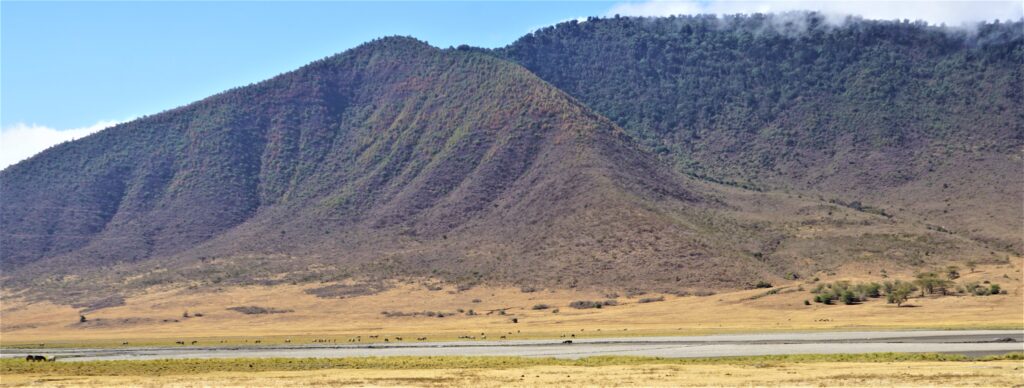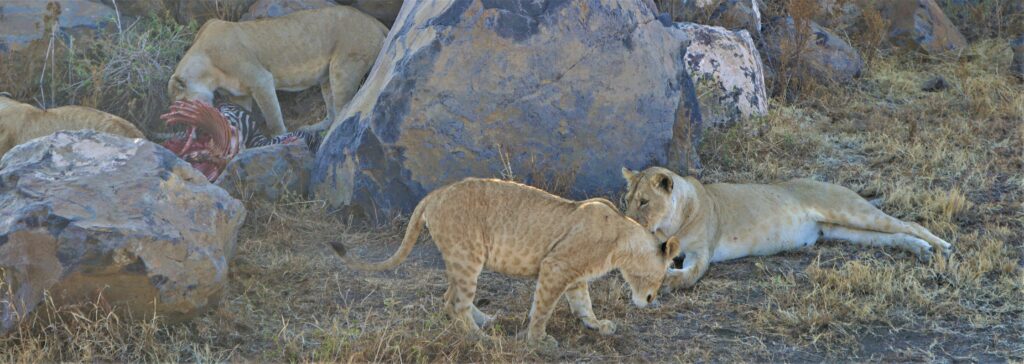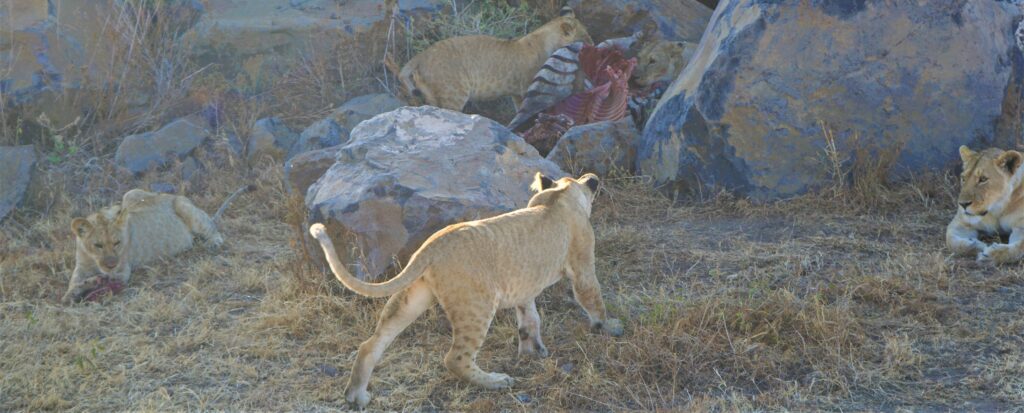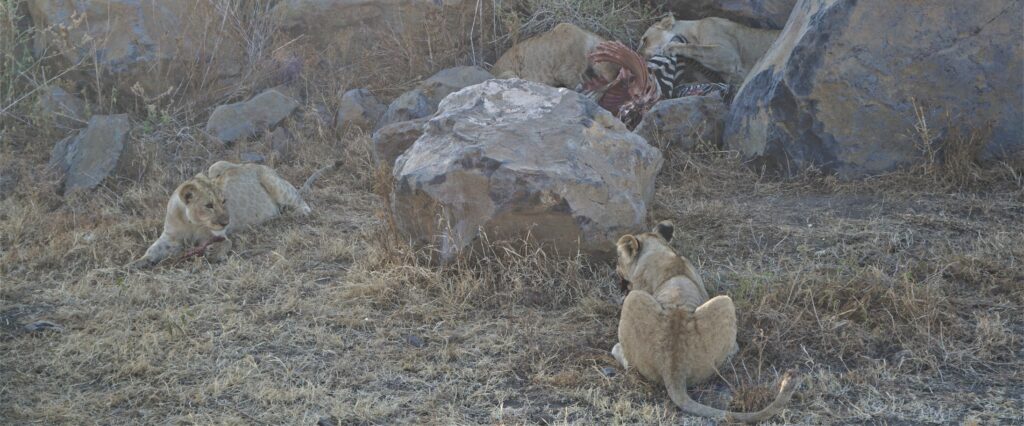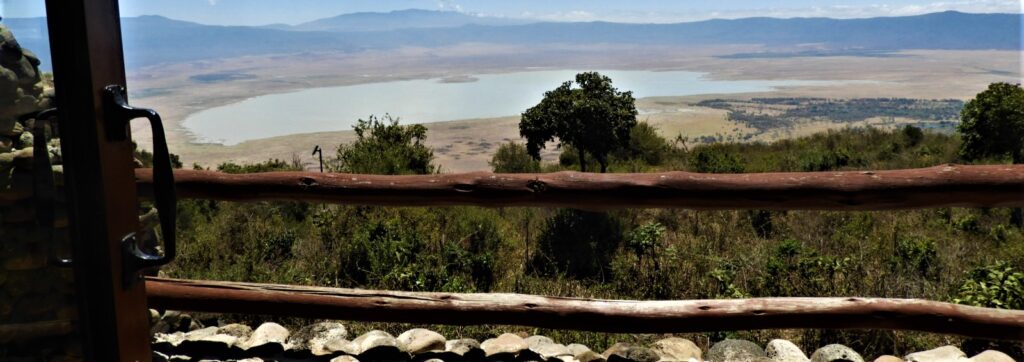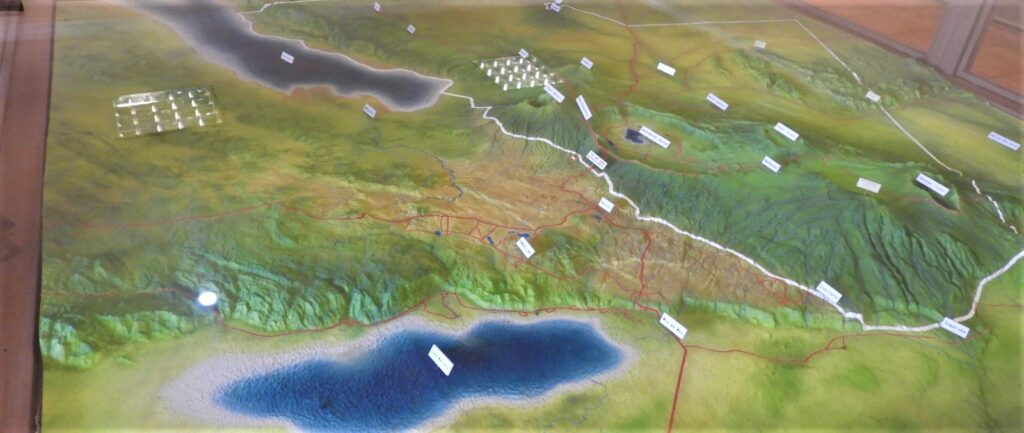Posts Tagged ‘Ngorongoro Crater’
» posted on Thursday, September 22nd, 2022 by Linda Lou Burton
Famous Restrooms
Linda Lou Burton posting from Ngorongoro Conservation Area, Tanzania– I thought of Glenny today. A coworker from way back in the 80s, she made the funniest remark about vacation photos I’ve ever heard. This was the era of the Brownie-Camera-Kodak-Film mode of remembering, when you couldn’t afford to take 20 shots of the same rock. Nor did you know how a shot would turn out until weeks after you returned home, got your six rolls developed, and stuck your 34 decent photos in an album. Glenny’s remark was “We always forgot to take pictures until we got out of the car at a restroom. So we’d ‘family group’ in front of the restroom doors and smile. My albums are Famous Restrooms of the World.”

 My gangmates and I didn’t “group up” in front of restroom doors today, but we did take photos INSIDE a positively glamorous construction as we blathered on about IT (the restroom) without even having a clue as to WHERE we were. I suppose, having signed up for a “safari tour” that was designed to see as many wild animals in Africa as possible, it wouldn’t be part of the Guide Dialog to focus on archeological and/or cultural sites, so when our 4x4s turned right at the “skulls” and then stopped at a washroom, no mention was made that we were stopping at some part of the Olduvai Gorge-Leakey Research-Museum complex. We didn’t get to the Museum, but heck, I surely “went” where early people “went” a few million years ago, according to the Leakeys. “Well, good on ya’, Mary and Louis Leakey,” I thought to myself. “Glenny, here’s one for the Famous Album!”
My gangmates and I didn’t “group up” in front of restroom doors today, but we did take photos INSIDE a positively glamorous construction as we blathered on about IT (the restroom) without even having a clue as to WHERE we were. I suppose, having signed up for a “safari tour” that was designed to see as many wild animals in Africa as possible, it wouldn’t be part of the Guide Dialog to focus on archeological and/or cultural sites, so when our 4x4s turned right at the “skulls” and then stopped at a washroom, no mention was made that we were stopping at some part of the Olduvai Gorge-Leakey Research-Museum complex. We didn’t get to the Museum, but heck, I surely “went” where early people “went” a few million years ago, according to the Leakeys. “Well, good on ya’, Mary and Louis Leakey,” I thought to myself. “Glenny, here’s one for the Famous Album!”
 We left Ngorongoro Serena Lodge at 8:30, passed the skulls at 9:30, and arrived at the Serengeti National Park Gate at 10:30, if you want to track our dirt-road route past all the things I mentioned in my last Post. Following are photos of what we saw, beginning with the giraffe on the Crater rim early on. Know why there are no giraffes IN the Crater? The descent is too steep for their long slender legs and neck. Note the herders and donkeys on their way to get water, the dry plains, the water sources, the everything. Funny – just as I said I’d never seen a dog helping with the Maasai herding, there was a frisky dog! Everyone waved.
We left Ngorongoro Serena Lodge at 8:30, passed the skulls at 9:30, and arrived at the Serengeti National Park Gate at 10:30, if you want to track our dirt-road route past all the things I mentioned in my last Post. Following are photos of what we saw, beginning with the giraffe on the Crater rim early on. Know why there are no giraffes IN the Crater? The descent is too steep for their long slender legs and neck. Note the herders and donkeys on their way to get water, the dry plains, the water sources, the everything. Funny – just as I said I’d never seen a dog helping with the Maasai herding, there was a frisky dog! Everyone waved.

Ngorongoro Conservation Area Authority https://www.ncaa.go.tz/
Mbuzi Mawe Serena Tented Camp https://www.serenahotels.com/mbuzi-mawe
Next Post: Damn! That Traffic Jam
» posted on Thursday, September 22nd, 2022 by Linda Lou Burton
Squiggles On The Map
Linda Lou Burton posting from Ngorongoro Conservation Area, Tanzania– This is about the NCA. Remember that map I bought at the Visitor Center? At the end of that overbooked day when Ben lectured so long we were two hours late getting to the Lodge? Well, truth be told, I didn’t retain much of what he said, but I have since been studying my $6 topographical map. So brace yourself to listen, here are some fascinating facts about “where I am.”
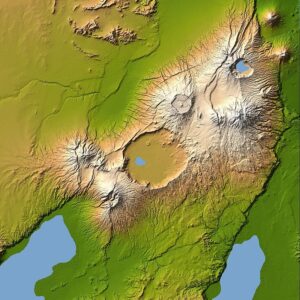 The Ngorongoro Conservation Area (hereafter referred to as NCA) in northern Tanzania was established 63 years ago (1959). It is an extension of the Serengeti (where we’re headed today). Seasonally, up to 2.5 million antelope, zebra, buffalo and wildebeests move around these two areas. The NCA is a UNESCO Mixed World Heritage Site and an International Man and Biosphere Reserve, and is often referred to as the 8th Wonder of the World.
The Ngorongoro Conservation Area (hereafter referred to as NCA) in northern Tanzania was established 63 years ago (1959). It is an extension of the Serengeti (where we’re headed today). Seasonally, up to 2.5 million antelope, zebra, buffalo and wildebeests move around these two areas. The NCA is a UNESCO Mixed World Heritage Site and an International Man and Biosphere Reserve, and is often referred to as the 8th Wonder of the World.
Size: NCA covers over 3,200 square miles of Africa’s wildlife, people, and archaeological sites. The heart of the NCA, the Ngorongoro Crater, with an area of 100 square miles and walls rising to a height of 2,000 feet, is the world’s largest intact volcanic caldera.
Wildlife: NCA, together with Serengeti National Park and other areas supporting the Serengeti ecosystem, supports the greatest concentration of wildlife on Earth. From June through October, the Serengeti Plains are dry, bare and dusty. From November through May, the rainy season, they turn lush green and millions of animals flood this rich pasture.
 People: Over the past few thousand years, a succession of cattle-herding people colonized this area from the North. The Maasai arrived about 300 years ago from Ethiopia, coming down the Nile River. Today, approximately 64,000 Maasai pastoralists live in the area with their cattle, donkeys, goats and sheep.
People: Over the past few thousand years, a succession of cattle-herding people colonized this area from the North. The Maasai arrived about 300 years ago from Ethiopia, coming down the Nile River. Today, approximately 64,000 Maasai pastoralists live in the area with their cattle, donkeys, goats and sheep.
 Activities in the Area: Walking, camping, and game viewing safaris. Cultural tourism experiences among Maasai and Hadzabe tribes. Visits to archaeological findings at Olduvai Gorge.
Activities in the Area: Walking, camping, and game viewing safaris. Cultural tourism experiences among Maasai and Hadzabe tribes. Visits to archaeological findings at Olduvai Gorge.
 Olduvai Gorge (Oldupai = Maasai spelling) is the historic place where Mary and Louis Leakey unearthed a jawbone in 1959, which pushed back the beginning of human evolution well past the 1.5 million year mark. The different kinds of hominids found here show a gradual increase in brain size and in the complexity of their stone tools. The Oldupai Museum is open daily at the Gorge, where visitors can learn more details of this fascinating story.
Olduvai Gorge (Oldupai = Maasai spelling) is the historic place where Mary and Louis Leakey unearthed a jawbone in 1959, which pushed back the beginning of human evolution well past the 1.5 million year mark. The different kinds of hominids found here show a gradual increase in brain size and in the complexity of their stone tools. The Oldupai Museum is open daily at the Gorge, where visitors can learn more details of this fascinating story.
 We pass through Olduvai Gorge on our way to Mbuzi Mawe Serena Tented Camp today, but with an 80+ -mile-drive on rutted dirt roads ahead, I’m guessing we won’t stop at the Museum. I’m listing interesting sites I see on the NCA map; you can check Google maps too. We have to travel along the Crater’s rim before beginning our descent; we’ll pass the Senato Gate which controls the Senato Descent Road into the Crater (Rick doesn’t remember if that’s the one they took). We’ll pass by Loonguku and Kiloko Cultural Bomas, all in the Oldupai Gorge; we’ll pass the road leading to Oldupai Museum, the Leakey Camp Research Station, Archeological Excavations, and Archeological Camp near Naiprosuet Hill. Then we enter the Serengeti Plain and Serengeti National Park. At the moment, all of this is just squiggles on a map. By tonight, they’ll be places I’ve been. Or at least, passed by.
We pass through Olduvai Gorge on our way to Mbuzi Mawe Serena Tented Camp today, but with an 80+ -mile-drive on rutted dirt roads ahead, I’m guessing we won’t stop at the Museum. I’m listing interesting sites I see on the NCA map; you can check Google maps too. We have to travel along the Crater’s rim before beginning our descent; we’ll pass the Senato Gate which controls the Senato Descent Road into the Crater (Rick doesn’t remember if that’s the one they took). We’ll pass by Loonguku and Kiloko Cultural Bomas, all in the Oldupai Gorge; we’ll pass the road leading to Oldupai Museum, the Leakey Camp Research Station, Archeological Excavations, and Archeological Camp near Naiprosuet Hill. Then we enter the Serengeti Plain and Serengeti National Park. At the moment, all of this is just squiggles on a map. By tonight, they’ll be places I’ve been. Or at least, passed by.
Alphabetical Listing of More NCA Things To See
- Empakaai Crater: Tiny crater, 2 square miles, lake and forest, great views over the Rift Valley and the cone of Oldonyo Lengai.
- Lerai Forest: Small forest of yellow barked acacia trees on the Ngorongoro Crater floor.
- Nasera Rock: Huge monolith 328 feet high in the Goi Mountains.
- Oldonyo Lengai: Still active volcano; climb the steep slopes to see the steaming, bubbling activity.
- Olkarien Gorge: Narrow Gorge in the Goi Mountains; during the rains, Maasai bring cattle here to drink.
- Olmoti Crater: Shallow grassy crater and source of the Munge River which pours through a notch in a spectacular waterfall on the rim of the Ngorongoro Crater.
- Shifting Sands: A little black sand dune marches across the plains, covering 56 feet a year; blown by a strong, steady wind, it maintains its size and elegant shape.

Ngorongoro Conservation Area Authority https://www.ncaa.go.tz/
Mbuzi Mawe Serena Tented Camp https://www.serenahotels.com/mbuzi-mawe
Next Post: Famous Restrooms
» posted on Thursday, September 22nd, 2022 by Linda Lou Burton
It’s Worth It!
Linda Lou Burton posting from Ngorongoro Serena Safari Lodge, Ngorongoro Crater, Tanzania– Gray. A soft, silent gray. That’s the first thing I saw when I opened my eyes. A misty fog came all the way to our balcony this morning. Unlike yesterday’s brilliant pink and  orange highlighting that hundred-mile view across the Crater, today’s fog encased our balcony like a cuddle blanket. A lot of poems have been written about fog. Some complain that fog is an obstacle, blocking out what you want to see; others consider it a relief, a kind of protection from things you don’t want to deal with. For me this morning, it was the latter. I was not in the mood for another “luggage out for pickup before dawn then haul ass into the 4×4 for a 4-hour bumpy ride across a dusty plain” kind of day. It wasn’t that I didn’t want to see the Serengeti (one of the most famous National Parks in the world); it was more that I wanted, needed, to stay longer where I was. I wasn’t DONE with the Crater. Or the Lodge.
orange highlighting that hundred-mile view across the Crater, today’s fog encased our balcony like a cuddle blanket. A lot of poems have been written about fog. Some complain that fog is an obstacle, blocking out what you want to see; others consider it a relief, a kind of protection from things you don’t want to deal with. For me this morning, it was the latter. I was not in the mood for another “luggage out for pickup before dawn then haul ass into the 4×4 for a 4-hour bumpy ride across a dusty plain” kind of day. It wasn’t that I didn’t want to see the Serengeti (one of the most famous National Parks in the world); it was more that I wanted, needed, to stay longer where I was. I wasn’t DONE with the Crater. Or the Lodge.
Despite the irritations of our specific tour’s missed deadlines and wanky upside down schedules that drained everyone’s strength and patience, none of that is a reflection on the facilities and services offered by the Lodge. The building is old and definitely not easy for those with walking difficulties to get around in; and its remote location makes it extremely difficult to get TO, but, I promise, it is so worth it! This is what they say about themselves:  The Ngorongoro Crater, a UNESCO World Heritage destination referred to as the Eighth Wonder of the World, is a location unlike any other in Tanzania and perhaps the world. Ngorongoro Serena Safari Lodge is an enchanting river-stone lodge seemingly fastened to the Crater rim by native vines, offering breathtaking views in every direction. With a
The Ngorongoro Crater, a UNESCO World Heritage destination referred to as the Eighth Wonder of the World, is a location unlike any other in Tanzania and perhaps the world. Ngorongoro Serena Safari Lodge is an enchanting river-stone lodge seemingly fastened to the Crater rim by native vines, offering breathtaking views in every direction. With a  mesmerizing expanse of plains, forests and lakes extending as far as the eye can see, the Lodge is surrounded by prehistoric stillness and landscapes. Arched stone passages and timbered decks, walls adorned with cave paintings and lit by flickering torches, and an eternally lit fireplace offer an incredible backdrop for your stay in Tanzania. From English breakfasts and sundowner cocktails at the Crater’s edge to game drives across the Crater floor and evening receptions with authentic Maasai music and dance performances, your stay will be distinguished by unforgettable moments.
mesmerizing expanse of plains, forests and lakes extending as far as the eye can see, the Lodge is surrounded by prehistoric stillness and landscapes. Arched stone passages and timbered decks, walls adorned with cave paintings and lit by flickering torches, and an eternally lit fireplace offer an incredible backdrop for your stay in Tanzania. From English breakfasts and sundowner cocktails at the Crater’s edge to game drives across the Crater floor and evening receptions with authentic Maasai music and dance performances, your stay will be distinguished by unforgettable moments.
 Is that an exaggeration? I’d have to say NO, it’s not! So I need another week to mess around here, to sit on my balcony and just breathe; to have lunch and an all-day game drive in the Crater (maybe twice); to take a slow-morning nature walk around the grounds and rim; to watch the Maasai herding their cattle down the steep Crater walls; and to study the geology of this unusual part of the world. The Olduvai Gorge for one; one of the most important paleoanthropological localities in the world. Maybe I can just hide in the fog today, and they won’t miss me?
Is that an exaggeration? I’d have to say NO, it’s not! So I need another week to mess around here, to sit on my balcony and just breathe; to have lunch and an all-day game drive in the Crater (maybe twice); to take a slow-morning nature walk around the grounds and rim; to watch the Maasai herding their cattle down the steep Crater walls; and to study the geology of this unusual part of the world. The Olduvai Gorge for one; one of the most important paleoanthropological localities in the world. Maybe I can just hide in the fog today, and they won’t miss me?
Ngorongoro Serena Safari Lodge https://www.serenahotels.com/ngorongoro/accommodation
Next Post: Squiggles On The Map
» posted on Wednesday, September 21st, 2022 by Linda Lou Burton
More From The Floor
Linda Lou Burton posting from Ngorongoro Serena Safari Lodge, Ngorongoro Crater, Tanzania– Rick confirms: the Crater was a great place to spend a day. “The descent road was steep,” he said. “The 4×4 was right on the edge, good thing it was still dark.” He couldn’t give  me specifics on the route they followed during the day; mostly a hodge-podge back-and-forth depending on where animals were spotted at a given point in time and information exchanged between drivers. “Not like Disneyland, where you know the Dancing Elephants will dance at 3:00 PM sharp and you buy a ticket for 3 PM!” They saw the lions having breakfast early on; they ate their own Boxed Breakfast – a boiled egg and pastries – “somewhere near a tree.” He switched between cameras; sometimes his phone; sometimes his Sony with the zoom lens. His photos illustrate what I observed from my balcony as I studied the map I’d bought the day before at the Visitor Center, trying to pinpoint specific places. The Crater has a variety of surprising landscapes! Ngoitokitok Springs with its picnic area is on the eastern edge of the Crater,
me specifics on the route they followed during the day; mostly a hodge-podge back-and-forth depending on where animals were spotted at a given point in time and information exchanged between drivers. “Not like Disneyland, where you know the Dancing Elephants will dance at 3:00 PM sharp and you buy a ticket for 3 PM!” They saw the lions having breakfast early on; they ate their own Boxed Breakfast – a boiled egg and pastries – “somewhere near a tree.” He switched between cameras; sometimes his phone; sometimes his Sony with the zoom lens. His photos illustrate what I observed from my balcony as I studied the map I’d bought the day before at the Visitor Center, trying to pinpoint specific places. The Crater has a variety of surprising landscapes! Ngoitokitok Springs with its picnic area is on the eastern edge of the Crater,  east of Gorigor Swamp; Lerai Forest in the southwest, fairly close below the Serena Lodge. My map stars a number of Points of Interest: Old German Farm Ruins; Goose Ponds and Hippo Pool in Mandust Swamp; Tatoga Ritual Site on the western edge of Lake Magadi. Senato Springs. Ololowaru Springs. Approximately 25,000 large animals live in the Crater. Large mammals include elephants, black rhinos, Cape buffalo, and hippos. Other ungulates: blue wildebeest, Grant’s zebra, eland, Grant’s and Thomson’s gazelles, and waterbucks; cheetah and leopard are rarely seen. Absent are giraffe and crocodile. Although the Crater is a “natural enclosure” for most wildlife, many wildebeest and zebra vacate the Crater in the wet season. Cape buffalo stay; their highest numbers are during the rainy season. Take a look at some of the pictures Rick took on September 21, 2022, down on the Floor. A variety of landscapes, a fair number of animals, and — other folks taking pictures!
east of Gorigor Swamp; Lerai Forest in the southwest, fairly close below the Serena Lodge. My map stars a number of Points of Interest: Old German Farm Ruins; Goose Ponds and Hippo Pool in Mandust Swamp; Tatoga Ritual Site on the western edge of Lake Magadi. Senato Springs. Ololowaru Springs. Approximately 25,000 large animals live in the Crater. Large mammals include elephants, black rhinos, Cape buffalo, and hippos. Other ungulates: blue wildebeest, Grant’s zebra, eland, Grant’s and Thomson’s gazelles, and waterbucks; cheetah and leopard are rarely seen. Absent are giraffe and crocodile. Although the Crater is a “natural enclosure” for most wildlife, many wildebeest and zebra vacate the Crater in the wet season. Cape buffalo stay; their highest numbers are during the rainy season. Take a look at some of the pictures Rick took on September 21, 2022, down on the Floor. A variety of landscapes, a fair number of animals, and — other folks taking pictures!
Next Post: More About The Lodge and the Surrounding Area
Ngorongoro Serena Safari Lodge https://www.serenahotels.com/ngorongoro/accommodation
» posted on Wednesday, September 21st, 2022 by Linda Lou Burton
A 10-Minute Slice
Linda Lou Burton posting from Ngorongoro Serena Safari Lodge, Ngorongoro Crater, Tanzania– Another promise kept. Partly. I promised a Post with Rick’s photos from his day in the crater, but gee, when I started looking at his photos, one 10-minute segment rose to the top like cream in a bucket of fresh Jersey milk. So here goes, a Beatrix Potter kind of story. For background, you need to know this: the lion population in Ngorongoro Crater is denser 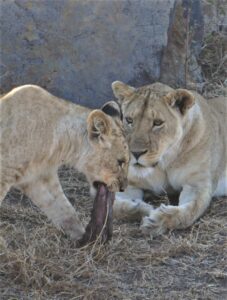 than anywhere else in Africa. Not the most lions of any protected area, but the most per square mile of land. And, they have their own ingrown quirks. Remember this: the Crater is a CLOSED area. The caldera is 100 square miles of land filled with grasses, water sources, and cover, often called a Garden of Eden. In other areas, such as the Serengeti-Maasai Mara, animals migrate by the millions in a year-round cycle, following food sources. In the Crater, they don’t have to. Climb Every Mountain isn’t their theme song; they just stay put! Rick and the gang came upon this pride (family) of Mom and Kids at meal time. Does Roger get to keep his chunk of zebra meat? Do his brothers manage to snatch it away? How does Mom manage the standoff? A cute (and typical kids!) story, any way you slice it.
than anywhere else in Africa. Not the most lions of any protected area, but the most per square mile of land. And, they have their own ingrown quirks. Remember this: the Crater is a CLOSED area. The caldera is 100 square miles of land filled with grasses, water sources, and cover, often called a Garden of Eden. In other areas, such as the Serengeti-Maasai Mara, animals migrate by the millions in a year-round cycle, following food sources. In the Crater, they don’t have to. Climb Every Mountain isn’t their theme song; they just stay put! Rick and the gang came upon this pride (family) of Mom and Kids at meal time. Does Roger get to keep his chunk of zebra meat? Do his brothers manage to snatch it away? How does Mom manage the standoff? A cute (and typical kids!) story, any way you slice it. 
Research on Ngorongoro Crater Lions https://kopelion.org/ngorongoro-lions/
This is KopeLion: KopeLion strives to foster human-lion coexistence in Ngorongoro Conservation Area. Here intensifying human-wildlife conflicts has been tough on the lions. In the last decades, the lions have begun to disappear entirely from their former ranges, separating the famous Ngorongoro Crater lions from the Serengeti. The area’s mission for harmonious coexistence is collapsing, with both people and wildlife losing out. KopeLion was founded in 2011 with the aim to change this trend. By working directly with residents, KopeLion strives for sustainable human-lion coexistence in Ngorongoro for the benefit of both people and lions. KopeLion, comprised of local experts and international scientists, employs former lion hunters to actively protect the remaining lions and reduce conflicts. Our work builds upon data collected over the last 50 years, representing the best-known, best-studied lions in the world. This offers the unique opportunity to measure the effects of our efforts on a population of lions, studied for generations.
The Ngorongoro Crater lion population is uniquely important. Studied almost continuously since 1963, it is the best-known, best-studied lion population in the world. Having become physically separated from the lion population in the nearby Serengeti National Park, the Crater lions have become a textbook example of the challenges facing an isolated inbred population. Our ongoing efforts to restore the connection between the Serengeti and the Crater offer a rare opportunity to measure the effects of lion conservation efforts in a population whose every member is individually recognized and observed over its entire lifespan. We receive a wealth of data on fine-scale movement, behaviors, and prey choice from a few “multi-use area lions” that we managed to GPS collar. One of the striking findings is lions’ capacity to adapt to living among people and livestock. While they clearly avoid areas with settlement and activities in the daytime, they seem to hesitate little to pass close by homesteads in the night.
Next Post: More From The Crater Floor
» posted on Wednesday, September 21st, 2022 by Linda Lou Burton
To Die For
Linda Lou Burton posting from Ngorongoro Serena Safari Lodge, Ngorongoro Crater, Tanzania– A promise kept. My room at Ngorongoro Serena Lodge has a splendid, to-die-for  private balcony overlooking the Crater, just as promised. Nothing is visible from my own private balcony but the Crater. Just: CRATER. I am happy with that. It’s Rick’s view too, but he’s down IN Crater today, while I am sitting on my (at this moment) own private balcony, looking AT it. Kinda makes me feel like God or something. At worst, an eagle. I started looking at Crater at 5:50 AM; that’s when the sun’s rays pinked it to life. Rick was long gone by then, and it was chilly on the balcony, but I made myself a cup of tea, wrapped a blanket around, and just sat there looking. Then, my head filled with images of crater-from-my-own-balcony, I crawled back into bed, still hoping to catch up on desperately needed sleep.
private balcony overlooking the Crater, just as promised. Nothing is visible from my own private balcony but the Crater. Just: CRATER. I am happy with that. It’s Rick’s view too, but he’s down IN Crater today, while I am sitting on my (at this moment) own private balcony, looking AT it. Kinda makes me feel like God or something. At worst, an eagle. I started looking at Crater at 5:50 AM; that’s when the sun’s rays pinked it to life. Rick was long gone by then, and it was chilly on the balcony, but I made myself a cup of tea, wrapped a blanket around, and just sat there looking. Then, my head filled with images of crater-from-my-own-balcony, I crawled back into bed, still hoping to catch up on desperately needed sleep.
 We didn’t get to the Lodge until 7:30 last night; after check-in and dinner and everything else, lights out was way after 10. Our drive from the Visitor Center (where Ben pulled his double-cross) was like something from a Washington Irving tale; the Headless Horseman riding through the dark at break-neck speed? Instead of a horse, we were in a 4×4 on a winding, rocky, unlit stretch of road going up the side of a mountain. Willy did his best, God love his soul, driving fast; we were running two hours late. A safari driver expects to drive in daylight hours, stopping frequently to watch animals doing animal things, right? A frightened baby buffalo was the only thing we saw in that wild ride, caught in our headlights as we rounded a curve.
We didn’t get to the Lodge until 7:30 last night; after check-in and dinner and everything else, lights out was way after 10. Our drive from the Visitor Center (where Ben pulled his double-cross) was like something from a Washington Irving tale; the Headless Horseman riding through the dark at break-neck speed? Instead of a horse, we were in a 4×4 on a winding, rocky, unlit stretch of road going up the side of a mountain. Willy did his best, God love his soul, driving fast; we were running two hours late. A safari driver expects to drive in daylight hours, stopping frequently to watch animals doing animal things, right? A frightened baby buffalo was the only thing we saw in that wild ride, caught in our headlights as we rounded a curve.
Later I’ll reflect on (and probably laugh about) all the things that have gone haywire in the first two days with Ben as our guide. But today, I have my balcony!
Look at what I looked at as the day progressed. All rooms in this two-story Lodge overlook the same awe-inspiring spectacle: The Ngorongoro Crater, the world’s largest inactive, intact and unfilled volcanic caldera. It is 2,000 feet deep and its floor covers 100 square miles. Lake Magadi is the seasonal salt lake in the center of the crater; there are many springs and swamps on the crater floor, important water supplies for the animals and the local Maasai. Note in some photo zooms trees, swamps, vehicles, and animals.
Ngorongoro Serena Safari Lodge https://www.serenahotels.com/ngorongoro
Next Post: Rick’s Photos From In The Crater
» posted on Tuesday, September 20th, 2022 by Linda Lou Burton
Double Cross Cross
 Linda Lou Burton posting from Ngorongoro Serena Safari Lodge, Ngorongoro Crater, Tanzania– It was 4:15 when we left Tloma school, all smiles and warm-glowy feelings. Such a good visit, such a happy buzz of conversation in the 4×4 as we headed down the road, stirring up a trail of red dust. I was calculating in my head: 25 miles to the rim of the Crater, we’d be checked into our Lodge and sitting on our balconies in time to see the sun set, oh yeah! (Sunset 6:30, keep in mind.) “But lo”, my scrappy angel said, “your 4×4 seems to be pulling into the drive of a small building just minutes from the school. And lo! Stopping.” Elephants and zebras and acacia trees captured on canvas, hanging on a line. Sailboats even!
Linda Lou Burton posting from Ngorongoro Serena Safari Lodge, Ngorongoro Crater, Tanzania– It was 4:15 when we left Tloma school, all smiles and warm-glowy feelings. Such a good visit, such a happy buzz of conversation in the 4×4 as we headed down the road, stirring up a trail of red dust. I was calculating in my head: 25 miles to the rim of the Crater, we’d be checked into our Lodge and sitting on our balconies in time to see the sun set, oh yeah! (Sunset 6:30, keep in mind.) “But lo”, my scrappy angel said, “your 4×4 seems to be pulling into the drive of a small building just minutes from the school. And lo! Stopping.” Elephants and zebras and acacia trees captured on canvas, hanging on a line. Sailboats even! 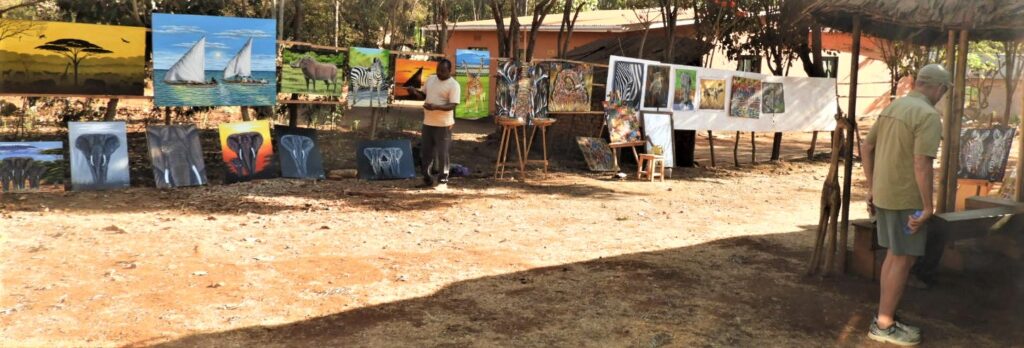 “We’re stopping here,” Ben said, “so you can browse around and find some nice paintings to buy. Some memories of Tanzania.” I looked at the scrappy angel sitting on my shoulder and vowed not to complain. Everyone else hustled out of the 4×4 and began browsing. Ben stayed with me. “Let’s talk about tomorrow,” he said. “We have decisions to make.” “Okay,” I responded, aiming for pleasant, “let’s talk.” Our schedule for tomorrow was ”All Day Game Drive in the Crater with Picnic Lunch.” Since the Crater was one of my main reasons for coming to Africa, I’d resolved since making my February trip deposit to go on THAT Game Drive if no other. Karen Blixen’s House and the Ngorongoro Crater, my two objectives.
“We’re stopping here,” Ben said, “so you can browse around and find some nice paintings to buy. Some memories of Tanzania.” I looked at the scrappy angel sitting on my shoulder and vowed not to complain. Everyone else hustled out of the 4×4 and began browsing. Ben stayed with me. “Let’s talk about tomorrow,” he said. “We have decisions to make.” “Okay,” I responded, aiming for pleasant, “let’s talk.” Our schedule for tomorrow was ”All Day Game Drive in the Crater with Picnic Lunch.” Since the Crater was one of my main reasons for coming to Africa, I’d resolved since making my February trip deposit to go on THAT Game Drive if no other. Karen Blixen’s House and the Ngorongoro Crater, my two objectives.
 I told Ben of my enthusiasm for the day ahead, a full day in the Crater, with picnic lunch. “We could do that,” he said. “Or, we could leave at 4:30 and be in the Crater before daylight. We could have BREAKFAST in the Crater and be back at the Lodge for lunch.” My scrappy angel shook a finger at me; warned me to stay cool. “We’ve had a really busy day today,” I said to Ben, in my most diplomatic tone. “A 4:30 departure in the morning would be a tight timeline. People would be more rested if we stuck to the original plan and departed at 6:30.” Ben nodded pleasantly and agreed. “You’re right, 4:30 is pushing it. We’ll stick to the plan.” We chatted more; he told about his studies; a Masters Program in Tourism (that school in Arusha I mentioned earlier); he told about his areas of interest; his goals after that.
I told Ben of my enthusiasm for the day ahead, a full day in the Crater, with picnic lunch. “We could do that,” he said. “Or, we could leave at 4:30 and be in the Crater before daylight. We could have BREAKFAST in the Crater and be back at the Lodge for lunch.” My scrappy angel shook a finger at me; warned me to stay cool. “We’ve had a really busy day today,” I said to Ben, in my most diplomatic tone. “A 4:30 departure in the morning would be a tight timeline. People would be more rested if we stuck to the original plan and departed at 6:30.” Ben nodded pleasantly and agreed. “You’re right, 4:30 is pushing it. We’ll stick to the plan.” We chatted more; he told about his studies; a Masters Program in Tourism (that school in Arusha I mentioned earlier); he told about his areas of interest; his goals after that.
 The browsers returned (no purchases); our journey continued, dusty road to tarred road; at 5:30 we reached the Ngorongoro Conservation Area Visitor Center. “We’re going in,” Ben motioned to the other 4×4, “so I can explain the Crater to you.” Inside we gathered around the giant relief map; Ben talked about the geology of the Crater; the Conservation Area today; the Great Migration; the wildebeests. “The wildebeests live in Kenya part of the year,” he said, “but they belong to Tanzania.” (Wildebeests have citizenship?) We fidgeted. My scrappy angel nodded off.
The browsers returned (no purchases); our journey continued, dusty road to tarred road; at 5:30 we reached the Ngorongoro Conservation Area Visitor Center. “We’re going in,” Ben motioned to the other 4×4, “so I can explain the Crater to you.” Inside we gathered around the giant relief map; Ben talked about the geology of the Crater; the Conservation Area today; the Great Migration; the wildebeests. “The wildebeests live in Kenya part of the year,” he said, “but they belong to Tanzania.” (Wildebeests have citizenship?) We fidgeted. My scrappy angel nodded off.
“Oh, about tomorrow,” Ben said, concluding his wildebeest claim, “if we leave the hotel at 4:30 in the morning we’ll be down in the Crater before daylight, in position to see the animals as they become active. We can have the hotel pack a box breakfast, and be back at the Lodge in time for lunch. You’ll have a free afternoon. Sound OK?” Like lemmings led to the sea, the gang nodded, “Yeah, sounds great.” I stood up. “Wait! The original plan was LUNCH in the Crater, leaving at 6:30 in the morning, not 4:30. And that’s what you agreed we’d do.”
All eyes back to Ben. “Who wants to see the most animals?” he questioned. Eight hands rose. “Who wants to sleep in and see fewer animals?” he asked then, looking at me. Ah, well, my scrappy angel was dialing up KARMA at that very moment.
Next Post: Notes From The Balcony of Ngorongoro Serena Safari Lodge https://www.serenahotels.com/ngorongoro
» posted on Thursday, September 1st, 2022 by Linda Lou Burton
The Safari Experience According to Globus
Linda Lou Burton posting from Little Rock, Arkansas – Here’s the outline of where we’ll be going on our “17 days from Nairobi to Zanzibar” long-awaited safari trip, as described by the Globus marketing department. We’ve opted to stay in Zanzibar an extra day to relax on the beach, before heading to Iceland on our own. Are we ambitious, or what?
 Globus Says: “Africa conjures up dreamy images of mystical mountains, savanna grasslands, and endless plains, but for the adventure seeker, it’s where the wild things are. The “Big 5”—lion, leopard, elephant, rhino, and Cape buffalo await you on this ultimate safari through East Africa. Featuring unique lodges and tented camps, custom-made 4-wheel-drive safari vehicles, and exclusive meals in the bush, this Kenya and Tanzania tour promises larger than life experiences
Globus Says: “Africa conjures up dreamy images of mystical mountains, savanna grasslands, and endless plains, but for the adventure seeker, it’s where the wild things are. The “Big 5”—lion, leopard, elephant, rhino, and Cape buffalo await you on this ultimate safari through East Africa. Featuring unique lodges and tented camps, custom-made 4-wheel-drive safari vehicles, and exclusive meals in the bush, this Kenya and Tanzania tour promises larger than life experiences and countless memories. You’ll savor the unique terrain and wildlife at seven renowned national parks, reserves, and conservancies, including the famous Maasai Mara National Reserve, and the vast, volcanic Ngorongoro Conservation Area. Beyond sightings of the “Big 5,” be on the lookout for cheetah, wildebeest, crocodile, hippo, and rhino. On the tamer side, you’ll also enjoy a visit to the Sweetwaters Chimpanzee Sanctuary as well as the endearing experience of meeting the local children at a primary school in Karatu.
and countless memories. You’ll savor the unique terrain and wildlife at seven renowned national parks, reserves, and conservancies, including the famous Maasai Mara National Reserve, and the vast, volcanic Ngorongoro Conservation Area. Beyond sightings of the “Big 5,” be on the lookout for cheetah, wildebeest, crocodile, hippo, and rhino. On the tamer side, you’ll also enjoy a visit to the Sweetwaters Chimpanzee Sanctuary as well as the endearing experience of meeting the local children at a primary school in Karatu.
 Explore more on your tour of Africa with Monograms packages to Nairobi and Zanzibar. In Nairobi, feed endangered giraffes at the Giraffe Center and meet orphaned elephant calves at the Sheldrick Wildlife Trust. Decelerate after an exhilarating vacation of game drives on a breezy, island getaway to Zanzibar. Move too fast and the hospitable locals will offer the gentle reminder, “Pole, pole!” meaning “Slowly, slowly!”
Explore more on your tour of Africa with Monograms packages to Nairobi and Zanzibar. In Nairobi, feed endangered giraffes at the Giraffe Center and meet orphaned elephant calves at the Sheldrick Wildlife Trust. Decelerate after an exhilarating vacation of game drives on a breezy, island getaway to Zanzibar. Move too fast and the hospitable locals will offer the gentle reminder, “Pole, pole!” meaning “Slowly, slowly!”
Each Globus Africa safari tour is limited to an average of just 20 guests per departure. There’s always room to roam with extra space between you and other travelers—while still getting up close and personal to the experiences you’ve been dreaming of. Small-Group Discoveries include all the features of a traditional Globus escorted tour, complete with expert Tour Director, Safari Guide/Driver, and Local Guides who ensure that your health and safety is our top priority.”
What do you think? What will we enjoy most? Will the mosquitos be as bad as we’ve been warned? Will the sunsets be as awesome? How many days in before we get tired? I’ll keep you posted.
If you’ve got the travel itch yourself after two years of COVID shutdown, check out the worldwide possibilities.
https://www.globusjourneys.com/
» posted on Tuesday, August 30th, 2022 by Linda Lou Burton
About Tanzania
Linda Lou Burton posting from Little Rock, Arkansas – After ten days in Kenya, with stops in Nairobi, Ol Pejeta Conservancy, Nakuru National Park, Maasai Mara National Reserve, and Amboseli National Park (where we’ll be peeking ahead at Mt Kilimanjaro!), we’ll cross the border into Tanzania. So what is the mystery of Tanzania? Here’s what I found.
 How big is Tanzania? Where is it? What does it look like?
How big is Tanzania? Where is it? What does it look like?
Tanzania is directly south of Kenya on Africa’s east coast, and for comparison to our US states, it’s bigger than Texas and almost as big as Alaska. Got that? Tanzania is mountainous and densely forested in the northeast, where 19,341-foot Mount Kilimanjaro, the highest point on the continent, is located. Three of Africa’s Great Lakes are partly within Tanzania. To the north and west lie Lake Victoria, Africa’s largest lake, and Lake Tanganyika, the continent’s deepest lake; to the south is Lake Malawi. The 885-mile Indian Ocean coastline is dotted with palm trees and white sands, with the Zanzibar Archipelago just off shore. Note Ngorongoro Crater there on the northern border!
How about Tanzania’s weather?
 Climate varies greatly within Tanzania. It’s cool in the high mountainous regions, with temperatures ranging between 50-68 during cold and hot seasons respectively. The eastern shore is hot and humid. The rest of the country has temperatures rarely falling lower than 68. There are two major rainfall periods – October through December and March through May; as you might guess June through September are great times to visit for long sunny days!
Climate varies greatly within Tanzania. It’s cool in the high mountainous regions, with temperatures ranging between 50-68 during cold and hot seasons respectively. The eastern shore is hot and humid. The rest of the country has temperatures rarely falling lower than 68. There are two major rainfall periods – October through December and March through May; as you might guess June through September are great times to visit for long sunny days!
Tanzania’s people population is estimated at 56.3 million, composed of about 120 ethnic, linguistic, and religious groups. These ethnic groups are primarily of Bantu origin; the pastoral Maasai are perhaps the most familiar. 64% of Tanzanians are Christian; 34% Muslim. Over 100 different languages are spoken in Tanzania, making it the most linguistically diverse country in East Africa. About 10% of Tanzanians speak Swahili as a first language and up to 90% as a second. Unlike its neighboring countries, Tanzania has not experienced large-scale ethnic conflicts, perhaps due to the effects of Swahili as a unifying language. As to animal wildlife, Tanzania has the largest animal population density of any country in the world. There are more animals per square mile of land in Tanzania than anywhere else, with 430 mammal species and 1,112 bird species. About 20% of Africa’s large mammals live in Tanzania.
How does Tanzania promote itself?
About a third of the country’s total area is protected to a degree as a national park, game reserve, marine park, forest reserve or the like. The Tanzania Tourism Board and Tanzania Parks websites offers choices of Things to Do and Places to Go, with plenty of information about all those parks and reserves. About Serengeti: Serengeti National Park is undoubtedly the best-known wildlife sanctuary in the world, home to the greatest wildlife spectacle on earth – the great migration of wildebeest and zebra. The resident population of lion, cheetah, elephant, giraffe, and birds is also impressive. Serengeti won the TripAdvisor Travelers Choice Award in 2021, named as the Best of the Best National Park in the World.
https://www.tanzaniatourism.go.tz/en/
https://www.tanzaniaparks.go.tz/
» posted on Friday, August 26th, 2022 by Linda Lou Burton
On The Crater’s Rim
Linda Lou Burton posting from Little Rock, Arkansas — It started with a hotel. Being a Holiday Inn-Best Western-LaQuinta aficionado from years of budget travel with my kids, and later, my cats, I viewed “overnight accommodations” as being handy places to pull off the highway come evening, get a bath, and sleep. A cinnamon bun and coffee in the breakfast area the next day got me back on the road quickly.
One day, studying “places I’d like to go someday” I stumbled across a safari tour to Africa, with a stop at the Ngorongoro Serena Safari Lodge, described in words that struck like magic:
Regularly voted one of the best hotels in the world, this unique lodge clings to the rim of the magnificent Ngorongoro Crater, the largest and most perfect volcanic crater on Earth. Long and low, the lodge is built from local river stone and camouflaged with indigenous vines. Designed to blend completely into the landscape, it is entirely invisible from the floor of the Crater 600 meters below. Hugging the contours of the jagged Crater rim, the lodge takes its inspiration from the so-called “Cradle of Mankind,” the prehistoric site of Olduvai Gorge, which lies close by. Linked by arched stone passages and timbered decks, its walls are decorated with stylized prehistoric cave paintings and lit by flaring torches.
This of course sent me on a reading binge about the Ngorongoro Crater, as well as a pronunciation guide. (uhng gr raang gr ow)
 Ngorongoro Crater is the world’s largest inactive, intact and unfilled volcanic caldera. The crater, which formed when a large volcano exploded and collapsed on itself two to three million years ago, is 2,000 feet deep and its floor covers 100 square miles. Estimates of the height of the original volcano range from 14,800 to 19,000 feet The crater floor is 5,900 feet above sea level. The crater was voted one of the Seven Natural Wonders of Africa and is a UNESCO World Heritage Site known as the Eighth Wonder of the World. Deep within its immense walls is a breath-taking blue-green landscape dotted with plains, lakes and forests; an eerie, otherworldly “land that time forgot” thick with massive bull elephants, rhinos, wildebeests and the highest concentration of lions in Africa.
Ngorongoro Crater is the world’s largest inactive, intact and unfilled volcanic caldera. The crater, which formed when a large volcano exploded and collapsed on itself two to three million years ago, is 2,000 feet deep and its floor covers 100 square miles. Estimates of the height of the original volcano range from 14,800 to 19,000 feet The crater floor is 5,900 feet above sea level. The crater was voted one of the Seven Natural Wonders of Africa and is a UNESCO World Heritage Site known as the Eighth Wonder of the World. Deep within its immense walls is a breath-taking blue-green landscape dotted with plains, lakes and forests; an eerie, otherworldly “land that time forgot” thick with massive bull elephants, rhinos, wildebeests and the highest concentration of lions in Africa.
Next question was: How do I get there, and when can I go? This wasn’t just something, this was REALLY something!
It reminded me of the planning of my trip to Antarctica. I knew the where, and the when I wanted to do it, last question was the HOW? As part of a research team studying penguins (not possible), as crew on a Russian fishing ship (not desirable), or on a small cruise ship, and, which one of those?
I quickly found there are many “safari” tours hauling folks around the most alluring spots in Africa – those that promise sightings of “the big 5” or treks in gorilla country; those headed to shimmering deserts or mountain-top lakes or rivers surging with crocodiles; all offering opportunities to go rugged, or go luxury. Which would be the best “fit” for me?
The Globus Tours site offered a reasonable package– start in Nairobi, visit four camps in Kenya, then three in Tanzania – location of that fabulous hotel overlooking that other-worldly crater – and then end the trip with beach time in Zanzibar. What year could this reasonably happen?
 Next step: enlist a fellow day dreamer to help believe it into reality. I pinned pictures of that hotel, and that crater, in easy view, to nudge me on.
Next step: enlist a fellow day dreamer to help believe it into reality. I pinned pictures of that hotel, and that crater, in easy view, to nudge me on.
Link to Ngorongoro Serena Safari Lodge
https://www.serenahotels.com/ngorongoro






























